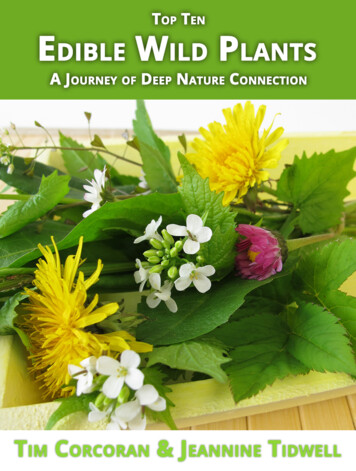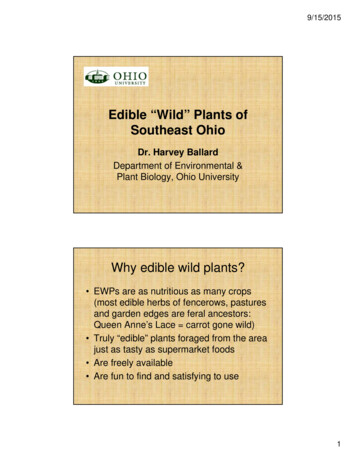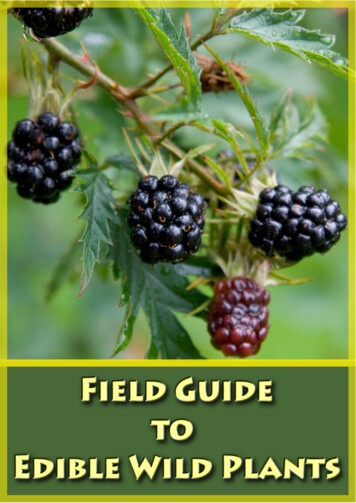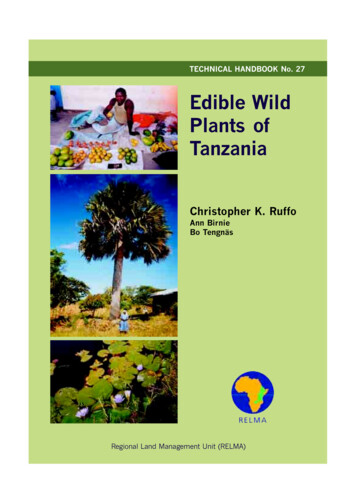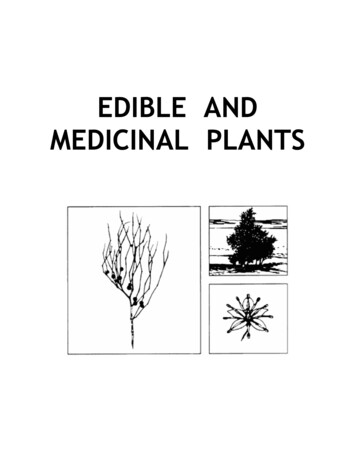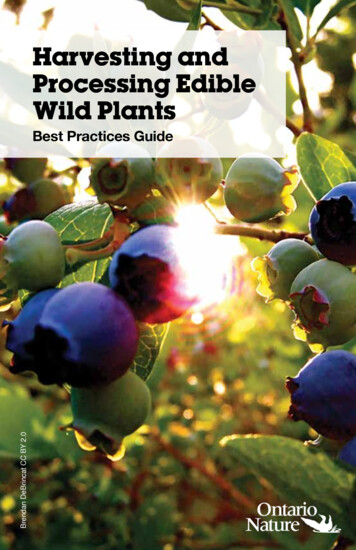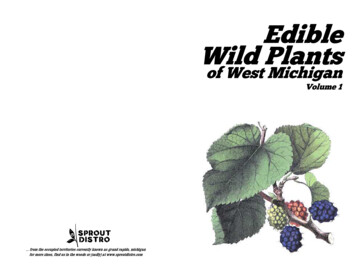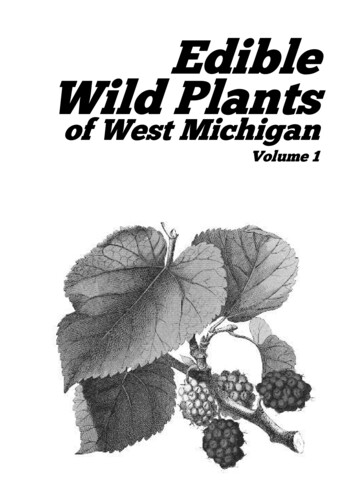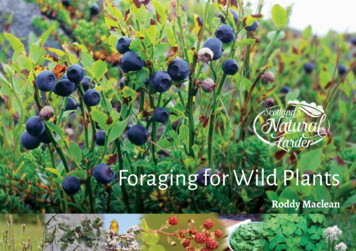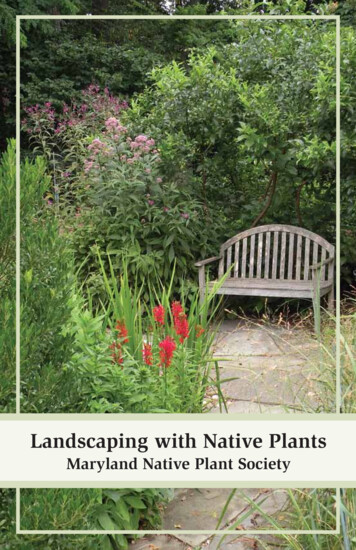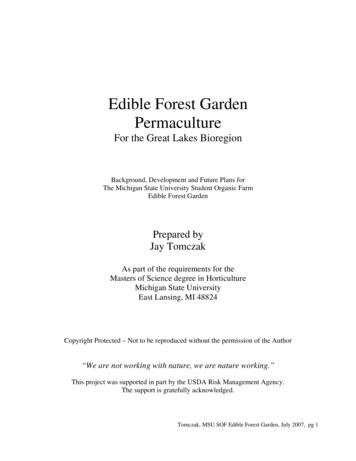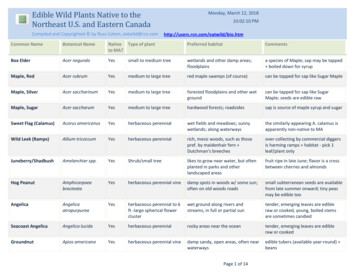
Transcription
Edible Wild Plants Native to theNortheast U.S. and Eastern CanadaCompiled and Copyrighted by Russ Cohen, eatwild@rcn.comMonday, March 12, 201810:02:10 PMhttp://users.rcn.com/eatwild/bio.htmCommon NameBotanical NameNative Type of plantto MA?Preferred habitatCommentsBox ElderAcer negundoYessmall to medium treewetlands and other damp areas;floodplainsa species of Maple; sap may be tapped boiled down for syrupMaple, RedAcer rubrumYesmedium to large treered maple swamps (of course)can be tapped for sap like Sugar MapleMaple, SilverAcer saccharinumYesmedium to large treeforested floodplains and other wetgroundcan be tapped for sap like SugarMaple; seeds are edible rawMaple, SugarAcer saccharumYesmedium to large treehardwood forests; roadsidessap is source of maple syrup and sugarSweet Flag (Calamus)Acorus americanusYesherbaceous perennialwet fields and meadows; sunnywetlands; along waterwaysthe similarly-appearing A. calamus isapparently non-native to MAWild Leek (Ramps)Allium tricoccumYesherbaceous perennialrich, mesic woods, such as thosepref. by maidenhair fern Dutchman's breechesover-collecting by commercial diggersis harming ramps habitat - pick 1leaf/plant onlyJuneberry/ShadbushAmelanchier spp.YesShrub/small treelikes to grow near water, but oftenplanted in parks and otherlandscaped areasfruit ripe in late June; flavor is a crossbetween cherries and almondsHog PeanutAmphicarpaeabracteataYesherbaceous perennial vinedamp spots in woods w/ some sun;often on old woods roadssmall subterranean seeds are availablefrom late summer onward; tiny peasmay be edible tooAngelicaAngelicaatropurpureaYesherbaceous perennial to 6ft -large spherical flowerclusterwet ground along rivers andstreams, in full or partial suntender, emerging leaves are edibleraw or cooked, young, boiled stemsare sometimes candiedSeacoast AngelicaAngelica lucidaYesherbaceous perennialrocky areas near the oceantender, emerging leaves are edibleraw or cookedGroundnutApios americanaYesherbaceous perennial vinedamp sandy, open areas, often nearwaterwaysedible tubers (available year-round) beansPage 1 of 14
Common NameBotanical NameNative Type of plantto MA?Preferred habitatCommentsSpikenard, AmericanAralia racemosaYesherbaceous perennialrich, often rocky, deciduous forests,growing on moist soilsripe berries are edible, and aromaticroots can be used to make a root beerlike beverageSilverweed, SaltmarshArgentina(Potentilla) egediiYesherbaceous perennialsalt marshes - a closely-relatedspecies (A. anserina) may growelsewherestarchy root is edible - leaves may beused for teaChokeberry, BlackAronia melanocarpaYessmall shrubsunny, usually (but not always)damp soil; can tolerate rocky, acidicconditionsat its best, its flavor only tolerable as araw fruit, but flavor is improved bycooking/sweeteningWild eous perennialrich, mesic woods, such as thosepref. by maidenhair fern Dutchman's breeches*NOTE: while the plant's roots give offa gingery aroma, the plant hascarcinogens so eat sparinglyMilkweed, CommonAsclepias syriacaYesherbaceous perennialold fields; field edges; roadsidesplant has at least four parts that areedible after boiling 7 minutesPawpawAsimina trilobaNo*small tree (to 20 ft.)understory tree in rich woodsnon-native to MA - Native to Zone 7 ,but will grow in shelteredmicroclimates to Zone 5OracheAtriplex spp.Yes*annual herbGrows at/just above the "wrack"(high tide) lineA. patula is non-native to MA; A.cristata and littoralis are native; youngleaves are edibleYellow BirchBetulaalleghaniensisYesmedium to large treehardwood forestspeeled twigs used for tea - sap can bedrunk or boiled down to a molasseslike syrupBlack BirchBetula lentaYesmedium to large treepioneer species for cleared areasand regenerating forestpeeled twigs used for tea - sap can bedrunk or boiled down to a molasseslike syrupAlpine BistortBistorta vivipara(Polygonumviviparum)Noherbaceous perennialmountain summits and open rockycold areasOnly occurs in colder microclimates innorthern New England furthernorth - "rare" status in ME NHSea RocketCakile edentulaYeslow-growing, herbaceous,succulent planton beaches, between the wrack lineand the duneleaves of this mustard family planthave a sharp, wasabi-like flavor - picka few leaves/plant onlyPage 2 of 14
Common NameBotanical NameNative Type of plantto MA?Preferred habitatCommentsMarsh Marigold(Cowslip)Caltha palustrisYesherbaceous perennial spring ephemeralwildflowerwooded swamps, usually near smallstreamsyoung leaves harvested sparinglybefore the plants bloom are edibleafter boilingToothwortCardamine(Dentaria) spp.Yesherbaceous perennial spring ephemeralwildflowerunderstory plant in rich woodsroot has horseradish flavor - be carefulnot to disturb listed (protected)species in the genusPennsylvania bittercressCardaminepensylvanicaYesherbaceous annual orbiennialwetlands, muddy river/lake/pondbanksraw and briefly cooked plant tastesomewhat like Horseradish (a relative)Pignut HickoryCarya glabraYesmedium to large treewoods and woods/field edges;more common in southern NewEnglandripe nuts are edible usually have anice flavor; C. ovata nuts are morereliably larger tastierHickory, ShagbarkCarya ovataYesmedium to large treeroadsides, field edges, hardwoodforestsbest trees for foraging are in the open get lots of sun - nuts ripen in lateSep. through mid Oct.Chestnut, AmericanCastanea dentataYessmall to medium tree(before blight hits them)hardwood forests; field edges;roadsidestrees 20 feet tall in good sunlight canproduce viable nuts before blight hitsNew Jersey TeaCeanothusamericanusYesherbfields and field and road edgesleaves used for tea - roots hostsymbiotic bacteria that can fixnitrogen for plant uptakeHackberryCeltis occidentalisYesmedium-sized treedamp areas with some good sunexposure; will grow near water,including seacoastboth thin-fleshed fruit and starchyseed are edibleRedbudCercis canadensisNosmall tree (to 15 feet)understory tree in limey or fertilesoilnot native to MA - Found only in SWN.E. further south, but will grow toZone 5BunchberryChamaepericlymenu Yesm canadenseground cover about 5-6"highnorthern and otherwise coolerwoodlands; likes some sunred berries are almost tasteless herbaceous perennialpioneer species following fires orclearcuts - like cool climateyoung shoots and pith in older stemsare edibleYesPage 3 of 14
Common NameBotanical NameNative Type of plantto MA?Preferred mNoannualrocky areas, esp. near the oceanmore likely to be spotted in northernNew England and further northwardSpring BeautyClaytonia virginica carolinianaYes*herbaceous perennial spring ephemeralwildflowerrich woods and woodedfloodplains - generally not found inacidic soils*C. virginica listed as endangered inMA - edible tubers ("fairy spuds") andfoliageClintonia (Corn Lily orBlue Bead Lily)Clintonia borealisYesherbaceous perennialground covercommon in acidic woodlands in N.NE and cool woods further Syoung (to 3") leaves are edible andtaste like cucumberSweet FernComptoniaperegrinaYesSmall shrubopen areas; sandy/gravelly soilleaves used for tea; small seeds areedible too - roots host symbioticbacteria that fix nitrogenHazelnut, CommonCorylus americanaYesshrubold fields, clearings, roadsides,often under power linesnuts are ripe the second week ofSeptemberHazelnut, BeakedCorylus cornutaYesshrubold fields, clearings, roadsides,often under power linesoverlaps with but tends to rangefurther north than C. americanaHawthornCrataegus spp.Yes*medium to large shrubold fields and field edgesfruits are red when ripe and vary insize and flavorPersimmonDiospyros virginianaNo*medium-sized treeold fieldsnon-native to MA - Native to Zone 7 but will grow in lower-numberedzones in suitable microclimatesBlack CrowberryEmpetrum nigrumNo*low-growing perennialfound on exposed mountain topsand ridges - higher elevations innorthern N.E.small fruit is edible but not particularlyyummyTrailing Arbutus(Mayflower)Epigaea repensYesprostrate plantopenings in acidic woodlands;sloping sides ofpaths woodsroads - likes some sunedible part are the spicy-scentedflowers, which are the state flower ofMATrout Lily, DogtoothVioletErythroniumamericanumYesherbaceous perennial spring ephemeralwildflowerrich woods; wooded floodplains;woods with rich humus layercooked bulbs are edible; raw plant isreputedly nausea-inducing if you eattoo muchBeechFagus grandifoliaYesmedium to large treeoften found in hardwood forestsnuts ripen in September; best trees forforaging grow in the openPage 4 of 14
Common NameBotanical NameNative Type of plantto MA?Preferred habitatCommentsWild StrawberryFragaria vescaYesherbaceous perennialdappled sunlight along woods roadsand woodland clearingssmall but tasty fruit; seeds stick out(on F. virginiana, seeds are indentedinto the fruit)Wild StrawberryFragaria virginianaYesherb to 4" highold fields; mowed areas; roadsidesthe fruit are small nut delectable;species likes cooler climateCreeping SnowberryGaultheria hispidulaYesprostrate, diminutive vine - cool, partial-to-full sun spots - oftenon old tree stumpswhite berries the same size and flavorof wintergreen ial to 5" highground cover in acidic woodlands can tolerate sunleaves used for tea - berries alsoedible (though not very sweet)Huckleberry, BlackGaylussacia baccataYessmall shrub (to 3' tall)acidic woodlands and clearingscommon understory plant in oakforestsblack fruit ripens a bit later thanblueberriesDangleberry tory plant in damp woods occasionally grows in the open orpartial shadeblue fruit ripens several weeks afterthe blueberriesWater or Purple AvensGeum rivaleYesperennial herblikes wet meadowy ground; cantolerate a bit of shaderoot can supposedly be used to makea chocolate-like drinkJerusalem ArtichokeHelianthustuberosusYes*herbaceous perennialfield edges floodplains; likes full suna Sunflower cousin w/ edible tubers*although here in 1620, speciesoriginated in Central N. AmericaCow ParsnipHeracleummaximumYesherbaceouswet meadows, stream banks,roadside ditchesyoung leaves and stems are edible,preferably boiled to reduce thestrongly aromatic flavorRose MallowHibiscus moscheutos Yesshrubin wet open meadows or in wetground along waterwaysspecies is related to Marsh Mallow(Althaea officinalis), for which theconfection was namedBeach Greens(Seabeach Sandwort)HonckenyapeploidesYesannual?Grows in sandy areas near high tidelineentire green part of plant is edibleWaterleaf, VirginiaHydrophyllumvirginianumYesherbrich woodsIs sporadic in N.E.; more common S. W. - the related H. canadense is listedas Endangered in MAPage 5 of 14
Common NameBotanical NameNative Type of plantto MA?Preferred habitatCommentsJewelweedImpatiens biflora orpallidaYesannualdamp meadows and woodlands;doesn't like full sunedible seeds taste like walnutsButternut/WhiteWalnutJuglans cinereaYesmedium -sized tree (to 40ft.)old fields; field edges; roadsidesnut inside egg-shaped husks/shells aremilder than Black WalnutsBlack WalnutJuglans nigraNo*medium to large treeold fields; field edges/roadsides*Not considered native to MA (nativefurther S.) but now grows wild there nuts ripen in OctoberWild LettuceLactuca canadensisYesannualfield edges; old fields; woods roadedges; roadsidesof the several wild species of Lactuca,this is the most palatableWood NettleLaportea canadensis Yesherbaceous perennialunderstory plant under hardwoods,usually mesic or damp soilscan be harvested and used (eatenaftercooking) in similar fashion toStinging Nettle, Urtica dioicaBeach PeaLathyrus japonicusvar. maritimusYesannualdunes and other seaside areasabove high tide linethe shoots tender green peas insidethe pods are edible cooked, inmoderationScotch LovageLigusticum scoticumYeshebaceous perennialrocky areas near the oceanyoung leaves, stems taste likecultivated lovage (a relative of celery)Canada LilyLilium canadenseYesherbacous perennialstream river banks, wetlandborders, high-terrace floodplainforests, roadsidesbulbs are edible raw or cooked, butplant is rarely abundant and too prettyto pickSpicebushLindera benzoinYesshrub (to 12 ft. tall)understory tree in acidichardwoods, esp, near small streamstwigs used for tea; berries may bedried ground up for a Szechuanpepper-like seasoningNorthern/MountainFly Honeysuckle(Waterberry)Lonicera villosaYessmall shrubrich woodsOccurs more frequently in northernthan southern New EnglandBugleweed/WaterHorehoundLycopus uniflorusYesherbaceous perennialdamp meadows and pond shoresa tuber-bearing wild mint - tubers areedible raw or cookedCanada Mayflower(False Lily of theValley)MaianthemumcanadenseYesherbacous diminutiveperennial ground coveracidic woodlands - tolerates shadewellsmall red berries are edible butreputedly cathartic in large amountsPage 6 of 14
Common NameBotanical NameNative Type of plantto MA?Preferred habitatCommentsFalse Solomon's SealMaianthemum orSmilacinaracemosumYesherbaceous perennialhardwood forests with rich humuslayeredible shoots and berries (reputedlycathartic in large amounts)Starry FalseSolomon's SealMaianthemumstellatumYesherbaceous perennialunderstory plant, in partial shade most commonly encountered nearthe coastshoots and ripe berries are edible;flowers and berries are larger andprettier than M. racemosaOstrich FernMatteucciastruthiopterisYesherbaceous perennial fernalluvial (silty) floodplain soil esp. inless acidic areasedible fiddleheads available in April;unsafe to eat rawIndian CucumberMedeola virginianaYesherbaceous perennialacidic, damp woods with richhumus layerharvesting the edible root kills theplant, so use sparingly - also don't pickrare orchid lookalikeOysterleafMertensia maritimaYes*herbrocky/shelly areas just above thehigh tide line*listed as Endangered in MA; morecommon in Northern/downeast Maine further N. - leaves ediblePartridgeberryMichella repensYesherbaceous perennialground cover in acidic woods,typically under pines/hemlockspretty red berries are edible (but havealmost no flavor)Wild BergamotMonarda fistulosaYesherbaceous perennialfield edges and roadsides - likes sunleaves used for tea and/or seasoningBayberryMorellacaroliniensis (form.Myricapensylvanica)YesShrubopen areas; sandy soilfresh leaves can be used as asubstitute for commercial bay leavesMulberry, RedMorus rubraYes*Small to medium treefield edges; roadsides; tolerant ofurban conditions*native species (M. rubra) listed asEndangered in MA; non-native M. albais common - hybrids alsoSweet GaleMyrica galeYessmall shrubin acidic swamps and alongwaterwaysaromatic leaves used for tea - rootshost symbiotic bacteria that can fixnitrogen for plant uptakeLotus, AmericanNelumbo luteaNoherbaceous perennialaquatic emergentshallow ponds and openmarshy/swampy areas*not native in MA; Native to Zone 7 orhigher but will grow in Zone 5 - edibleseeds tubersPage 7 of 14
Common NameBotanical NameNative Type of plantto MA?Preferred habitatCommentsSpatterdock, Cow LilyNuphar variegataYesherbaceous perennialaquatic plantshallow portions of lakes, pondsand slow-moving riversripe seeds can reportedly be roastedin a skillet like popcornWhite Water LilyNymphaea spp,.Yesaquatic plantshallow areas of lakes and pondsflower buds are edible boiled; otherparts of the plants may also be edibleEvening PrimroseOenothera biennisYesbiennialold cultivated fields, roadsides,above high tide linea native weed with an edible root aftercooking; other tender parts of theplant are also edibleEastern Prickly PearOpuntia humifusaYes*small cactusdunes, barrier beaches and othersandy areas near ocean*listed as endangered in MA and veryuncommon in the wild in N.E.; morecommon further southSweet Cicely;AniserootOsmorhizalongistylisYesherbaceous perennialrich woods; river floodplains;tolerates shade wellwhole plant smells and tastes likelicorice; closely related species (O.claytonii) does notWood Sorrel,Mountain or WhiteOxalis montanaYesherb to 3" highground cover in acidic damp coniferwoodlandscommon in White Mountains; lesscommon further southWood Sorrel, VioletOxalis violaceaYes*herbaceous perennialgrows on ridges and rocky slopesunder a partially open forest canopy*this is a listed (uncommon) species inNew England, so should not begathered from the wildMountain SorrelOxyria digynaNosmall herbmountain tops and cool damp rockyareasOnly occurs in cold microhabitats innorthern New England and furthernorthwardDwarf GinsengPanax trifoliumYesherbaceous perennialdamp woods w/ good humus layer;often near streamssmall, spherical tuber is edible harvest only when abundantPassionfruit(Maypops)Passiflora incarnataNo*herbaceous vinerailroad ballast and waste places likes full sunnon-native to MA - Native to Zone 7and higher - can grow in lower zonesin warmer microclimatesGround Cherry, HuskTomatoPhysalis spp. (*P.heterophylla isnative to MA)Yes*annual (P. heterophylla isperennial)edges of cultivated fields; likes sunripe, tomato-like berries enclosed inpapery husk (calyx) - ripens latesummer onwardPage 8 of 14
Common NameBotanical NameNative Type of plantto MA?Preferred ceous perennialfield edges; roadsides; dirt piles andother disturbed areas; likes sunonly edible part are cooked shoots 4 10" high (be sure to avoid the highlycathartic root)White PinePinus strobusYesmedium to large treeoften grows in extensive stands informer old fieldsyoung needles, branchlets, male conesare edible raw or cooked; needlesused for teaSeaside Plantain(Goosetongue)Plantago maritimavar. juncoidesYesherbaceous perennial upto 10 " tallrocky areas near the oceanbe careful not to mix up withArrowgrass, Triglochin maritima,which can be poisonousMay ApplePodophyllumpeltatumYes*herbaceous perennialunderstory plant in hardwoodforests with rich soil*native status in MA is uncertain; ripefruit is only edible part of plantSolomon's SealPolygonatum spp.Yesherbaceous perennialunderstory species in hardwoodforests with rich humus layeryoung shoots are ediblePickerelweedPontedaria cordataYesherbaceous perennialaquatic emergentshallow margins of lakes, ponds andmeandering riversyoung leaves and seeds are edible (butmight not be tasty)Plum, AmericanPrunus americanaYessmall treesunny fields, roadsides, power linecorridorssmallish fruit, red when ripe, varies inflavor but can be just about as good asa domesticated plumBeach PlumPrunus maritimaYessmall shrubby tree (to 8feet tall)dunes and other sandy areas nearcoastlineCan be found in sandy areas inlandPlum, CanadaPrunus nigraYessmall treesunny fields, roadsides, power linecorridorssmallish fruit, red when ripe, varies inflavor but can be just about as good asa domesticated plumFire or Pin CherryPrunus pensylvanicaYessmall tree (up to 25 feet)pioneer species colonizing clearingsand old fieldsbright red fruit is very small butpleasant-tasting - ripens in JulyBlack CherryPrunus serotinaYesmedium to large treepioneer species in cleared areas;field edges/roadsidescherries ripen in the latter half ofsummerChoke CherryPrunus virginianaYesshrubby small tree (to 12ft.)old fields; field edges; roadsides;clearings - tolerates cool climatea bit more common in northern NewEngland than southern NEPage 9 of 14
Common NameBotanical NameNative Type of plantto MA?Preferred habitatCommentsBracken FernPteridium aquilinumYesherbaceous perennial fernold fields; clearings; tolerates driercondions than most other fernsedible cooked fiddleheads are tastybut carcinogenic in large amounts; eatsparingly (if at all)Mountain MintPycnanthemum spp.Yessmall herbedges of woods roadscan be uncommon so use sparinglywhen gathering from the wild;White OakQuercus albaYesmedium to large treehardwood forests; field edges;roadsidesacorns from this species tend to havelower levels of tannic acid, therebyrequiring less leachingSwamp White OakQuercus bicolorYesmedium to large treewooded swamps; floodplainsacorns have reputedly less tannic acidcontent than most other Oak speciesChestnut OakQuercus prinusYesmedium to large treecan tolerate dry, rocky and/orsloping conditionsacorns are edible after processing(leaching out the tannic acid)Red OakQuercus rubraYesmedium to large treein forests, roadsidesacorns are edible, but may requiremore extensive leaching than Q. albato render them palatableMeadow BeautyRhexia virginicaYessmall herbwet open meadows and lake/pondshorelineswhole plant has tangy flavor;uncommon so use sparinglyRoserootRhodiola roseaNoherbaceous perennialrocky exposed areas - usually closeto the oceanMostly found in cold rocky coastalhabitats in Maine and furthernorthward - roots smell like rosesLabrador TeaRhododendron(Ledum)groenlandicumNosmall shrubacidic, open rocky or boggy habitatsmore common in northern NewEngland and further north - leavesused (in moderation) for teaWinged (aka Shining)SumacRhus copallinumYesshrubsunny fields, roadsides, power linecorridorssour fruit used to make a pinklemonade-like beverageSumac, SmoothRhus glabraYesshrubold fields; field edges; roadsidesred fruit used to make a pinklemonade-like drink - peeled youngshoots are also edibleSumac, StaghornRhus typhina (hirta)YesShrub to 15 feet tallold fields; field edges; clearingsred fruit used to make a pinklemonade-like drink - peeled youngshoots are also ediblePage 10 of 14
Common NameBotanical NameNative Type of plantto MA?Preferred habitatCommentsCurrants/GooseberriesRibes triste andother spp.Yes*small perennials (up to 4'tall) w/ spindly branchesunderstory plant in dampwoodlands; can also grow nearwatermixture of native/introduced species all produce edible fruitWild RoseRosa spp.Yes*shrubold fields, swamps*The non-native Rosa rugosa is betterspecies for eating due to its larger tastier petals and hipsBakeapple Berry(Cloudberry)RubuschamaemorusNoherbaceous perennial (lessthan one foot tall)boggy areas; seeps in open rockyareasMostly found in Northern NewEngland Mountains and bogs andfurther north into CanadaDewberryRubus hispidusYesProstrate blackberrycousinold fields; clearingsfruit has the same size, appearanceand flavor as upright blackberryspeciesRaspberry, RedRubus idaeusYesherbaceous perennialold fields; field edges; woodsclearingstea made from the fresh or thoroughlydried leaves is edible, medicinal forwomenRaspberry, BlackRubus occidentalisYesherbaceous perenniallikes field edgespurplish-colored canes make theplants easy to spot in the "off-season"Flowering RaspberryRubus odoratusYesherbaceous perennialroadsides; wooded clearings; likescool damp conditionsshowy pink flower large maple-likeleaves; not thorny- fruit pulp is a bitthin dry but OK tasteBlackberryRubus spp.Yesherbaceous perennialold fields; field edges/roadsides;clearingsR. allegheniensis, pensilvanicus several other spp. are native to MAArrowhead (Wapatoor Duck Potato)Sagittaria latifoliaYesherbaceous perennialemergent aquaticshallow areas of lakes ponds;sunny swampsedible tubers are available Oct.-MarGlasswortSalicornia spp.YesherbGrows in salty areas in coastalmarshestender portions of plants can be eatenraw, steamed or pickled; pick tendertips onlyElderberry,Common/BlackSambucus nigra(aka canadensis)Yesshrub (to 10 ft' tall)wet open meadowsflowers used for beverages andfritters; ripe fruit edible after drying orcookingPage 11 of 14
Common NameBotanical NameNative Type of plantto MA?Preferred habitatCommentsSassafrasSassafras albidumYessmall tree (to 30 ft., butusually much smaller)understory tree in hardwoodforests; field edges; roadsidesaromatic root bark used for tea, candy,etc. - young leaves are dried for filepowderSaxifrageSaxifraga spp.Yesherbwoodland seeps, esp. non-acidicyoung leaves of several species areedibleBulrush, esherbaceous perennialemergent aquaticshallow ponds and open swampsthe plant is reputed to be edible in asimilar fashion as cattailCarrion FlowerSmilax herbaceaYesherbaceous perennialthornless vinedamp meadows field/roadsideedges; stinky flowers pollinated bycarrion fliesharvest, cook and eat shoots likeAsparagus (a relative)Sweet GoldenrodSolidago odoraYesherbold fields; rocky areas; under powerlines; sandy areas near the oceannative to all counties in MA - leavesand flowers have a licorice-like flavorWoundwortStachys hyssopifoliaYes*herbdamp meadows*S. hyssopfolia is a "watch species" inMA - pick the non-native (to MA) S.palustris insteadTwisted StalkStreptopuslanceolatusYes*herbrich woods; woodlands with richhumus layer*species is "watch-listed" in MA, soshouldn't be harvested from the wildin that stateTwisted-stalkStreptopuslanceolatus andamplexifoliusYesherbaceous perennialunderstory species near streamcourses, found more frequently inmtns.leaves are edible, as is fruit (which isreminiscent of cucumber orwatermelon)Basswood/AmericanLindenTilia americanaYesmedium to large treefield edges, roadsides, river banks can tolerate damp conditionsleaf buds and young leaves are edibleraw; blossoms are used for anedible/medicinal teaRedTrillium/WakerobinTrillium erectumYesherbaceous perennialmoist, deciduous forests, underash, sugar maple or basswoodyoung leaves edible raw or cooked taste like cucumber; gather only whenabundantCattail, CommonTypha latifoliaYesherbaceous perennialaquatic emergentshallow areas of waterways; marshyareas - likes full sunhas at least five different edible partsElm, SlipperyUlmus rubraYesmedium-sized treedamp fields; floodplainsseeds and inner bark are ediblePage 12 of 14
Common NameBotanical NameNative Type of plantto MA?Preferred habitatCommentsBellwort, PerfoliateUvularia perfoliataYesherbaceous perennialwoods with good humus layer likes shadeyoung shoots are edible like asparagusBellwort, SessileUvularia sessifoliaYesherbaceous perennialcommon understory herb ofdeciduous forests, esp. under Ash,Maple or Lindenyoung shoots and flowers are edibleBlueberry, LowbushVacciniumangustifoliumYessmall shrub (up to 2 ft tall)acidic woodlands, old fields, rockyand boggy areasflowers and berries are edibleBlueberry, HighbushVacciniumcorymbosumYesshrub (up to 8 ft tall)acidic woodlands, old fields,lake/pond shorelinesflowers and berries are edibleCranberry, BogVacciniummacrocarponYesprostrate vine - rarelymore than a foot tallacid bogs and seeps - likes sunsame species (and flavor) as thecultivated cranberryCranberry, SmallVacciniumoxycoccosYesprostrate vine - rarelymore than a foot tallacid bogs and seeps - likes sunfruit has similar flavor (albeit smallerthan) V. macrocarpon: cranberryspecies that is cultivatedDeerberryVacciniumstamineumYesSmall shrublikes acidic rocky areasberries are edibleCranberry, MountainVaccinium vitisidaeaYes*low-growing perennial (upto 1' tall)mountain peaks and cool habitats innorthern New Englandsame species as Lingonberry - *listedas endangered in MASquashberryViburnum eduleNo*shrubopen meadows, along streams rural roadsides;*natural range is N.part of N.NEV. edule is consistently tasty (tho tart)and is the tastiest of the various"highbush es(alnifolium)Yesshrubcommon understory plant in coolforestsfruit ripens and September and tasteslike a prune with a hint of cloveNannyberryViburnum lentagoYesshrubwet meadows; near waterwaysfruit ripens in September and is prunelike in flavor and textureWild RaisinViburnum nudum orcassinoidesYesshrubunderstory plant in open hardwoodforestssmall fruit are ripe when purply-blackin colorBlack HawViburnumprunifoliumNo*shrubdamp meadows - likes partial to fullsun - native only as far as SW NewEnglandripe fruit is edible, with prune-liketexture and flavorPage 13 of 14
Common NameBotanical NameNative Type of plantto MA?Preferred habitatCommentsHighbush CranberryViburnum trilobumYesshrubsunny swampy areas - morecommon in northern New EnglandDon't plant V. opulus, a Europeanspecies that tastes horribleViolet, Common Blueor DooryardViola sororiaYesperennial herbfields; meadowsthere are many other violets, somerare some w/ laxative effect - stick toeating this speciesFox GrapeVitis labruscaYesperennial vineroadsides; field edges; river bankslarge grapes are ripe the second weekof Sept. - young leaves may be stuffedRiverside GrapeVitis ripariaYesperennial vineroadsides, fences, field edges; riverbanksfruit is smaller, ripens later and not astasty as V. labrusca - young leaves aregood for stuffingPrickly-ash, CommonZanthoxylumamericanumYessmall treesunny roadsides, power lines,occurs mostly in w. N.E. where soilis less acidicfruit and foliage have a mouthnumbing quality; fruit is related toSzechuan peppercornsWild Rice, SouthernZizania aquaticaYesaquatic (emergent) grassstill and slow-moving shallowwater, rooted in silty and muddyflatsripe seed of this grass is "wild rice"Wild Rice, NorthernZizania palustrisYes*aquatic (emergent) grassstill and slow-moving shallowwater, rooted in silty and muddyflatsripe seed is "wild rice"; Z. palustris is alisted species in MA so should not beharvested therePage 14 of 14
Edible Wild Plants Native to the Northeast U.S. and Eastern Canada Monday, March 12, 2018 . field edges; roadsides plant has at least four parts that are edible after boiling 7 minutes Pawpaw Asimina triloba No* small tree (to 20 ft.) . before the plants bloom are edible after boili
